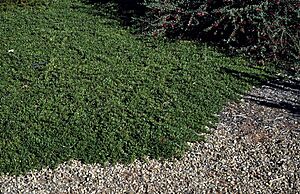Prostrate eremophila facts for kids
Quick facts for kids Prostrate eremophila |
|
|---|---|
 |
|
| Eremophila biserrata growing in the Scotia Sanctuary in NSW | |
| Conservation status | |
| Scientific classification | |
| Genus: |
Eremophila (plant)
|
| Species: |
biserrata
|
Eremophila biserrata, also called prostrate eremophila, is a flowering plant that belongs to the figwort family, Scrophulariaceae. This plant is special because it is only found in a small part of southern Western Australia. It's a prostrate shrub, which means it grows flat along the ground. It can spread out to cover an area of about 2 square metres (22 square feet). Its leaves have jagged edges, and its flowers are usually green and yellow.
Contents
About the Prostrate Eremophila
Eremophila biserrata is a shrub that grows flat on the ground. It often has long, snake-like stems that can reach up to 1 metre (3 feet) long. If conditions are just right, this plant can spread out to be 4 to 5 metres (13 to 16 feet) wide! Its leaves grow in different ways: sometimes they are spread out, and sometimes they are grouped together like rosettes. They are usually about 18 to 24 millimetres (0.7 to 0.9 inches) long and 5 to 11 millimetres (0.2 to 0.4 inches) wide. The leaves are shaped like a spear, wider at the bottom.
The edges of the leaves are serrated, meaning they have jagged, saw-like teeth. Sometimes, these teeth even have smaller teeth on them, making the leaf look like it has separate small leaves.
The flowers usually grow one by one where the leaves meet the stem. They are on short stalks, usually 3 to 5 millimetres (0.1 to 0.2 inches) long. Most of the time, the flowers are hidden among the leaves, so you can only see their tips. Each flower has 5 green sepals, which are like small leaf-like parts that protect the flower bud. These sepals are about 4 to 5 millimetres (0.16 to 0.20 inches) long.
The 5 petals of the flower are 15 to 20 millimetres (0.6 to 0.8 inches) long. They are joined together at the bottom to form a tube shape. The tube and the tips of the petals are green and yellow, but sometimes they can be pale red. Inside the flower, there are 4 stamens (the parts that produce pollen) that stick out far beyond the petal tube. This plant usually flowers between September and November. After the flowers, it produces dry, oval-shaped fruits that are about 4 to 5 millimetres (0.16 to 0.20 inches) long.
How it Was Named
The plant Eremophila biserrata was first officially described by a scientist named Robert Chinnock in 1979. His description was published in a science journal called Journal of the Adelaide Botanic Garden. Chinnock found the first example of this plant, called the type specimen, about 4 kilometres (2.5 miles) north of the road between Hyden and Lake Cronin. The second part of its scientific name, biserrata, refers to its unusual leaves that have double-serrated (jagged) edges.
Where it Grows
This type of eremophila plant is found in areas near Hyden and Lake King in Western Australia. These areas are known as the Coolgardie and Mallee biogeographic regions. It likes to grow in sandy and clay soils, especially near salt lakes and places where fresh water collects.
Protecting the Plant
The Government of Western Australia's Department of Parks and Wildlife has given Eremophila biserrata a special status called "Priority Four". This means that the plant is rare or nearly threatened, and efforts are being made to protect it so it doesn't disappear.
Growing it in Gardens
Prostrate eremophila is a great plant for gardens because it grows low to the ground. It can be used instead of grass in areas where people don't walk much, as it doesn't grow tall. It's quite easy to grow new plants from cuttings, which are small pieces of the plant that can grow roots. They usually start growing in just a few weeks. When you first plant it, make sure to keep it moist, especially during hot weather. This plant can grow well in full sun or in the shade under taller plants. It can also handle frost and doesn't need a lot of water once it's established.



